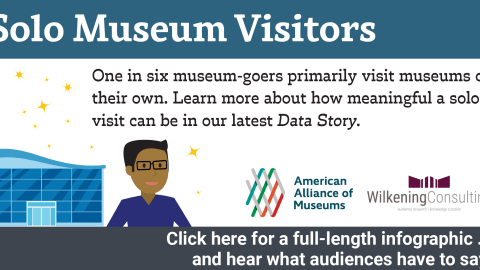In November, the Smithsonian’s Michael Edson threw down the gauntlet here on the Blog, with Museums in an Age of Scale. Michael challenged museums to dream big, especially when it comes to education. He concluded:
“Museums accomplish wonderful things in society, but a billion learners—that’s the kind of dream we need to have.”
This challenge provoked a lively response, particularly regarding the question of whether small museums can have a large scale impact outside their local communities. In a recent interview, I invited Michael to respond to some of the points raised about small museums, “big scale” and what it means for the future of museums.
Elizabeth:
It can be hard for small museums to think about working globally or achieving the kinds of results that larger, regional or national institutions can get, let alone how to reach the kinds of audiences that TED or the Khan Academy reach. One commenter on your original post said, “For those who can affect lives half a world away—great. But most museums can’t do that nor should they try.”
Michael:
I’ve been studying groups that work at a big scale, and with users across the globe, for a few years now, and I just don’t small teams as being that big of an impediment. The obstacles tend to be more conceptual—about organizations imagining that they could work big, global, and open—and also about institutions trying to maintain strict control and a kind of authoritative tone.
There’s a great story in Andrew Lih’s The Wikipedia Revolution about Nupedia, which was the precursor to Wikipedia. The concept of Nupedia was that it would have expert editors and a very formal editorial and review workflow that would include volunteers in a very constrained manner—and they found that it just didn’t scale. I think there were, like, 12 articles produced in the first year. And the whole process was intimidating, even for the founders. Not fun. No way to get people energized.
I was just watching Derek Muller’s video about How to Start a YouTube Channel. Derek runs three science video blogs called Veritasium, which have 172 videos, 1.2 million subscribers, and 54 million views. He’s on TV now (in Australia), which helps draw more attention to his YouTube channel, but there’s nothing he’s doing in terms of technology or concept that can’t be done by someone in a museum: it’s just him and a camera. His focus is “addressing counter-intuitive concepts in science, usually beginning by discussing ideas with members of the public” –that’s very museum-like, I think.
Anyway, in How to Start a YouTube Channel, Derek says…Here, let me play it for you.
“If you think that you’re being restricted by time or money or equipment, then you’re fooling yourself and you need to just get out there and start making stuff […] My advice sounds so simple: start making videos. So why don’t we? Why does everyone find it so difficult? Well, the answer is, you want to make something that’s good, that’s popular, that everyone likes. You’re worried that, what if you make it and nobody does like it, or it’s bad. And so rather than face that reality, you just don’t make anything.”
Again, Derek’s has done 172 videos and he’s got 54 million views. This isn’t Gangnam Style: it’s science education. Beth Harris and Stephen Zucker at SmartHistory have a very similar story to tell with their Art History content. Art history! And they’re reaching 2 million learners a semester, in 200 countries…For art history!
There’s just an enormous, humongous, gigantic audience out there, connected to the Internet, that is starving for good ideas, authentic ideas, and they want to learn. I don’t think museums really understand how huge the Internet is—how much attention and curiosity a couple of billion people can have.
Elizabeth:
You mentioned, in one of your replies, a woman who curates Pinterest boards about archaeology. What’s that all about?
Michael:
[Laughing…] Well, it seems that anybody can work big on the big social networks, like Pinterest, and a lot of the work there looks very relevant to what museums do.
[Laughing…] Well, it seems that anybody can work big on the big social networks, like Pinterest, and a lot of the work there looks very relevant to what museums do.
I gave a talk for the Danish Museum Awards in 2012 called Lego Beowulf and the Web of Hands and Hearts, all about how amateurs and do-it-yourselfers are out-doing museums at their own game. When I was researching that talk I asked my Danish colleagues what the most famous cultural artifact in Denmark was, and they told me it was probably the Solvongen, or, in English, the Trundholm Sun Chariot.
The National Gallery of Denmark has a nice, traditional web page about the Trundholm Sun Chariot, but I found this woman named Sunnifa Heinreksdottir who had included the Solvongen in a Pinterest board of Bronze Age artifacts, alongside related artifacts from other museums around the world, and I thought it was just fantastic. And on Pinterest she followed, and was followed by, people all over the world. Africa, the USA, Belgium, Ireland, England, and one lady said she was from “a little village of 20 houses in the North of Germany.” It was clear that Sunnifa Heinreksdottir was curating, and doing it quite well, and her immediate social network—her followers, and their followers—included over 28,000 people from all over the world. And I think she’s got 30 times more followers now than she did in 2013, so that 28,000 person network is probably exponentially bigger now.
So the point of that example is that one woman, not a celebrity in the conventional sense of the term, can indeed affect a lot of people, all over the world, with very little technology expertise or cost. Flickr is another place where I see this kind of thing happening.
[You can see the story of Sunnifa Heinreksdottir in Michael’s slides on Slideshare here: starting with slide #86. A written-out version of this talk is also on Slideshare.]
Elizabeth:
But still, don’t big museum brands have a greater chance of success on these online platforms, for all kind of reasons?
Michael:
That was almost entirely true before the Internet, but it’s less and less true every day.
In the old days, getting really big required a TV station, a printing plant or factory, a distribution network… And in that era, getting big usually meant leveraging traditional forms of marketing and PR to get, kind of, linear levels of growth. I mean, Proctor and Gamble spent almost $3 billion on marketing in 2011 alone—that’s a huge investment—and they only grew 4% in sales.
When we think of the old kind of “big” in museums…maybe we’re talking about making blockbuster exhibitions: we usually think of branding, concept development, and traditional marketing to get a physical audience through the doors, and there are limits to how big that can grow. And big organizations can play that game better than small ones, so they win. But the Internet isn’t like that: It’s a new game. Reddit has spent $0 on marketing and PR. Zero. And in December they had 5.8 billion page views, 100 million unique users, 20 million votes. And it’s a site about curiosity, discussion, question asking. Isn’t that our business too? Barak Obama answers questions on Reddit. Our Smithsonian curators answer questions on Reddit. The top three “Ask me anything” sessions on Reddit are Barak Obama, Bill Gates, and Sir David Attenborough. What museum wouldn’t be proud to host a discussion with people like that?
Elizabeth:
Michael, one commenter raised the point that museum content might not naturally translate to an online format, unlike TED talks, which seem to translate naturally to the online world.
Michael:
Well, first of all, what a museum is is not immutable. Museums used to be elaborate men’s clubs. In the early days of the British Museum, if you wanted to visit you had to send in a written application and submit to an interview to determine of you were worthy. So, museums—what we think of as museumness—changes in response to the world around us. And it’s the same with TED.
TED didn’t start out online. They started web video as a very tentative experiment, back in 2006. It was not at all clear that people would watch a scientist or a writer give a 20 minute talk on their computers, over the Internet. But the TED team tried it, and it worked a little, so they tried some more, and now TED has over 1 billion views.
And here’s the kicker: the success of all of that has gone back and dramatically changed the founder’s and team’s concept of what TED is, how it works, and what it can be. TED started out as a snooty conference for elite guests who could afford a $4,000 ticket and now, because of what the web can do, at scale and with participation, it has become something much more than that. Their users translate TED talks into over 104 languages. Their users take the TEDx brand and make their own conferences. The web has changed the brand and the direction of TED, and it can change our brands and directions too.
The point I’m making isn’t that every museum should be TED, it’s that every museum could be TED. Museums can, with small teams and not much money, now work at enormous scale – – interactively, compassionately, and with deep impact on individuals across the globe. That’s never been true before. Ever. And it’s only just getting started: 2.4 billion people are now online (the last time I checked) and the next 5 billion are not far behind.
For institutions that aspire to have a big impact on the world, scale isn’t just another goal or tactical option: it redefines what they can be, how big they can dream, and—most importantly—what we should expect them to accomplish for us, with us, in society.









As always, Michael is spot-on about what museums could be doing in the digital age – and Michael brilliantly lays out the issues – the digital age is all about scale. With big numbers comes lots of information (qualitative and quantitative) about what works in terms of videos etc and what doesn't work. This information is incredibly valuable!
Just one thing – at Smarthistory at Khan Academy we have an edited, peer reviewed, free, not-for-profit online art history resource that is NOT cumbersome in its process. And – contributions are open to art historians, curators, archaeologists, historians. We usually publish an article within a month after its submitted. Last month we published 30 new articles. See our Trello Board – an open call for articles: https://trello.com/b/jJcQr8mH/write-for-smarthistory-at-khan-academy